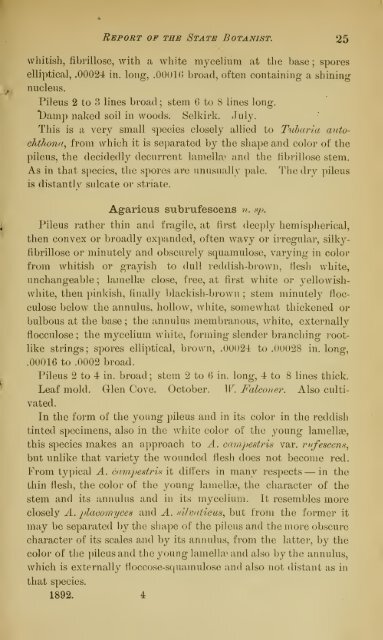Annual Report of the State Botanist 1892 - MykoWeb
Annual Report of the State Botanist 1892 - MykoWeb
Annual Report of the State Botanist 1892 - MykoWeb
Create successful ePaper yourself
Turn your PDF publications into a flip-book with our unique Google optimized e-Paper software.
<strong>Report</strong> <strong>of</strong> <strong>the</strong> <strong>State</strong> <strong>Botanist</strong>. 25<br />
whitish, fibrillose, with a white mycelium at <strong>the</strong> base ; spores<br />
elliptical, .00024 in. long, .OOUlO broad, <strong>of</strong>ten containing a shining<br />
nucleus.<br />
Pileus 2 to 3 lines broad ; stem 6 to 8 lines long.<br />
"Damp naked soil in woods. Selkirk. July.<br />
This is a very small species closely allied to Tuharia auto-<br />
chthons , from which it is separated by <strong>the</strong> shape and color <strong>of</strong> <strong>the</strong><br />
pileus, <strong>the</strong> decidedly decurrent lamellae and <strong>the</strong> fibrillose stem.<br />
As in that species, <strong>the</strong> spores are unusually pale. The dry pileus<br />
is distantly sulcate or striate.<br />
Agaricus subrufescens n. sp.<br />
Pileus ra<strong>the</strong>r thin and fragile, at first deeply hemispherical,<br />
<strong>the</strong>n convex or broadly expanded, <strong>of</strong>ten wavy or irregular, silky-<br />
hbrillose or minutely and obscurely squamulose, varying in color<br />
from whitish or grayish to dull reddish-brown, flesh Avhite,<br />
unchangeable ; lamellae close, free, at first white or yellowish-<br />
white, <strong>the</strong>n pinkish, finally blackish-brown ; stem minutely floc-<br />
culose below <strong>the</strong> annulus, hollow, white, somewhat thickened or<br />
bulbous at <strong>the</strong> base ; <strong>the</strong> annulus membranous, white, externally<br />
flocculose ; <strong>the</strong> mycelium white, forming slender branching root-<br />
like strings; spores elliptical, brown, .00024 to .00028 in. long,<br />
.00016 to .0002 broad.<br />
Pileus 2 to 4 in. broad ; stem 2 to H in. long, 4 to 8 lines thick.<br />
Leaf mold. Glen Cove. October. W. Falconer. Also culti-<br />
vated.<br />
In <strong>the</strong> form <strong>of</strong> <strong>the</strong> young pileus and in its color in <strong>the</strong> reddish<br />
tinted specimens, also in <strong>the</strong> white color <strong>of</strong> <strong>the</strong> young lamellae,<br />
this species makes an approach to A. cam.j'estris var. rufescens,<br />
but unlike that variety <strong>the</strong> wounded flesh does not become red.<br />
From typical A. cu/mijentrU it differs in many respects — in <strong>the</strong><br />
thin flesh, <strong>the</strong> color <strong>of</strong> <strong>the</strong> young lamellae, <strong>the</strong> character <strong>of</strong> <strong>the</strong><br />
stem and its annulus and in its mycelium. It resembles more<br />
closely A. placoinyces and A. Ktlvdiicus^ but from <strong>the</strong> former it<br />
may be separated by <strong>the</strong> shape <strong>of</strong> <strong>the</strong> pileus and <strong>the</strong> more obscure<br />
character <strong>of</strong> its scales and by its annulus, from <strong>the</strong> latter, by <strong>the</strong><br />
color <strong>of</strong> <strong>the</strong> pileus and <strong>the</strong> young lamelUv and also by <strong>the</strong> annulus,<br />
which is externally floccose-squamulose and also not distant as in<br />
that species.<br />
<strong>1892</strong>. 4
















